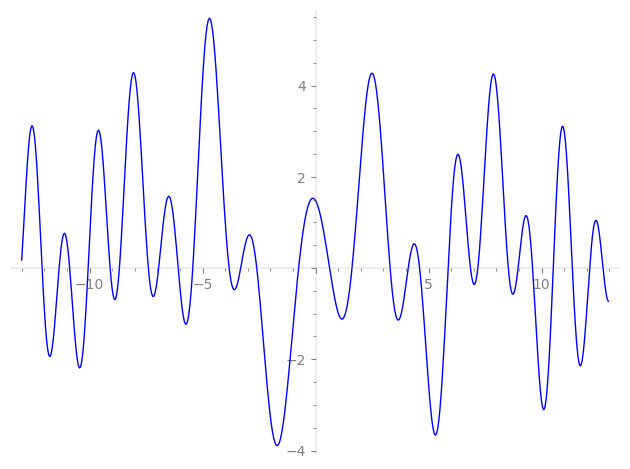| L(s) = 1 | + (−3.31 + 5.73i)5-s + (−8.46 + 4.88i)7-s + (10.0 − 5.80i)11-s + (8.93 − 15.4i)13-s − 2.37·17-s − 14.0i·19-s + (35.9 + 20.7i)23-s + (−9.43 − 16.3i)25-s + (−5.68 − 9.85i)29-s + (−18.0 − 10.4i)31-s − 64.7i·35-s − 35.7·37-s + (2.62 − 4.55i)41-s + (54.4 − 31.4i)43-s + (−4.28 + 2.47i)47-s + ⋯ |
| L(s) = 1 | + (−0.662 + 1.14i)5-s + (−1.20 + 0.698i)7-s + (0.914 − 0.528i)11-s + (0.687 − 1.19i)13-s − 0.139·17-s − 0.738i·19-s + (1.56 + 0.902i)23-s + (−0.377 − 0.653i)25-s + (−0.196 − 0.339i)29-s + (−0.581 − 0.335i)31-s − 1.85i·35-s − 0.965·37-s + (0.0641 − 0.111i)41-s + (1.26 − 0.731i)43-s + (−0.0911 + 0.0526i)47-s + ⋯ |
\[\begin{aligned}\Lambda(s)=\mathstrut & 1728 ^{s/2} \, \Gamma_{\C}(s) \, L(s)\cr =\mathstrut & (0.640 - 0.768i)\, \overline{\Lambda}(3-s) \end{aligned}\]
\[\begin{aligned}\Lambda(s)=\mathstrut & 1728 ^{s/2} \, \Gamma_{\C}(s+1) \, L(s)\cr =\mathstrut & (0.640 - 0.768i)\, \overline{\Lambda}(1-s) \end{aligned}\]
Particular Values
| \(L(\frac{3}{2})\) |
\(\approx\) |
\(1.479163049\) |
| \(L(\frac12)\) |
\(\approx\) |
\(1.479163049\) |
| \(L(2)\) |
|
not available |
| \(L(1)\) |
|
not available |
\(L(s) = \displaystyle \prod_{p} F_p(p^{-s})^{-1} \)
| $p$ | $F_p(T)$ |
|---|
| bad | 2 | \( 1 \) |
| 3 | \( 1 \) |
| good | 5 | \( 1 + (3.31 - 5.73i)T + (-12.5 - 21.6i)T^{2} \) |
| 7 | \( 1 + (8.46 - 4.88i)T + (24.5 - 42.4i)T^{2} \) |
| 11 | \( 1 + (-10.0 + 5.80i)T + (60.5 - 104. i)T^{2} \) |
| 13 | \( 1 + (-8.93 + 15.4i)T + (-84.5 - 146. i)T^{2} \) |
| 17 | \( 1 + 2.37T + 289T^{2} \) |
| 19 | \( 1 + 14.0iT - 361T^{2} \) |
| 23 | \( 1 + (-35.9 - 20.7i)T + (264.5 + 458. i)T^{2} \) |
| 29 | \( 1 + (5.68 + 9.85i)T + (-420.5 + 728. i)T^{2} \) |
| 31 | \( 1 + (18.0 + 10.4i)T + (480.5 + 832. i)T^{2} \) |
| 37 | \( 1 + 35.7T + 1.36e3T^{2} \) |
| 41 | \( 1 + (-2.62 + 4.55i)T + (-840.5 - 1.45e3i)T^{2} \) |
| 43 | \( 1 + (-54.4 + 31.4i)T + (924.5 - 1.60e3i)T^{2} \) |
| 47 | \( 1 + (4.28 - 2.47i)T + (1.10e3 - 1.91e3i)T^{2} \) |
| 53 | \( 1 - 75.7T + 2.80e3T^{2} \) |
| 59 | \( 1 + (-50.3 - 29.0i)T + (1.74e3 + 3.01e3i)T^{2} \) |
| 61 | \( 1 + (5.93 + 10.2i)T + (-1.86e3 + 3.22e3i)T^{2} \) |
| 67 | \( 1 + (-20.6 - 11.9i)T + (2.24e3 + 3.88e3i)T^{2} \) |
| 71 | \( 1 - 46.4iT - 5.04e3T^{2} \) |
| 73 | \( 1 + 104.T + 5.32e3T^{2} \) |
| 79 | \( 1 + (18.0 - 10.4i)T + (3.12e3 - 5.40e3i)T^{2} \) |
| 83 | \( 1 + (24.4 - 14.0i)T + (3.44e3 - 5.96e3i)T^{2} \) |
| 89 | \( 1 + 73.0T + 7.92e3T^{2} \) |
| 97 | \( 1 + (-71.1 - 123. i)T + (-4.70e3 + 8.14e3i)T^{2} \) |
| show more | |
| show less | |
\(L(s) = \displaystyle\prod_p \ \prod_{j=1}^{2} (1 - \alpha_{j,p}\, p^{-s})^{-1}\)
Imaginary part of the first few zeros on the critical line
−9.088472763273953251584500355285, −8.679471711304319509092264558569, −7.39723783760333373731275755478, −6.94292178054469432978241722252, −6.07678282728684526561891756533, −5.43345546999974190255841073497, −3.82346293919948490983869754758, −3.31305889775713543430505037574, −2.60173087509471537641655157478, −0.75049583103660921942832770521,
0.62223691732670770157375763182, 1.61209278386186234806112718698, 3.29942540513124194009142602075, 4.10006132173133668442110105051, 4.60244781395857930331283790870, 5.86264812217211015203714421477, 6.85379904273355350041331290051, 7.17846513430844773537585396953, 8.528574951676218401905453470373, 8.959120371614516380570183427653

